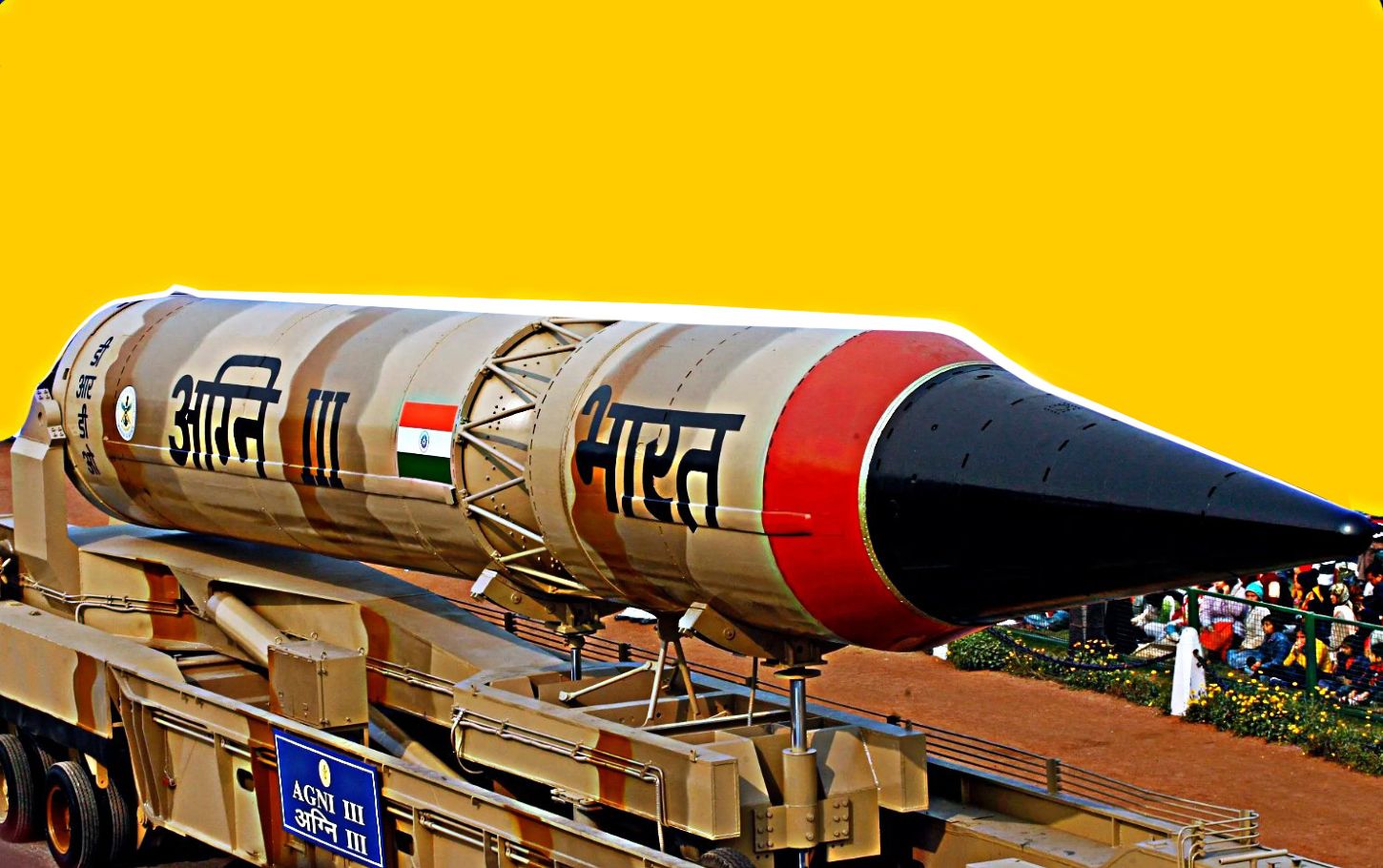OPED By: Gp Capt TP Srivastava
Now that Pakistan has enunciated its India-centric nuclear weapons policy, India must change its stance and reject the idealistic and strategically inconsequential No First Use policy and prepare its armory with Miniature Nuclear Warheads.
The ‘Little Boy’ was the name given to the first nuclear weapon to be dropped over Hiroshima on August 6, 1945, by the USAF B-29 Bomber named Enola Gay, flown by Major Paul Tibbet.
Enola Gay was the name of Paul Tibbet’s mother. ‘Little Boy’ weighed 9,700 Kg and had a yield of less than 20 kilotons. The world moved on, and the biggest nuke, the Tsar Bomba, the Russian megaton yield bomb, then became a reality.
One of the major requirements of nukes remains the delivery platform. ICBMs (Inter-Continental Ballistic Missiles) and MRBMs (Medium-Range Ballistic Missiles) are formidable and reliable delivery platforms and have different names in different nations.
The revolutionary development of delivery vehicles has been the ability to carry multiple warheads. In strategic parlance, the term used for such capability is the Multiple Independently Targetable Reentry Vehicle (MIRV). MIRV-ed ballistic missile viz Agni-5 enhances a nation’s capability manifold.
MIRV-ed Capability
It enables simultaneous attacks on more than one target, with one ICBM carrying maybe 10 warheads. The actual number of warheads carried by various ICBMs remains classified.
However, a reasonable guess places most ICBMs capable of carrying at least six warheads. Multiple warheads require launch vehicles to be able to lift off with large payloads.
For instance, six ‘Little Boys’ would weigh nearly 58,000 Kg. Such lift-off capability does not exist in all nations. Hence, nuclear scientists have been trying to miniaturize the nukes, reducing their weight without compromising on yield.
Most nuclear weapon states, including India, must have attained some success in this field. If the weight of a 20-kiloton yield bomb is reduced to a mere 1000 kgs, an ICBM capable of lifting a 6,000-kg payload can easily be launched with six such bombs. The factual data on miniaturization remains a closely guarded secret by all nations.
Current Status
India continues to bury itself under the weight of its utterly flawed and outdated nuclear doctrine. The core problem of continuance with the ‘Cold War’ era policy espoused by nuclear powers, which not only used nukes as weapons but also carried out thousands of tests, including megaton weapons. Hence, to adapt to their doctrinal philosophy in itself was/is a disturbing and strategically insane option.
The world and India continue to entwine themselves in the Cold War era terminology, viz. Flexible Response, Massive Retaliation, and so on.
Iran is virtually at the doorstep of going nuclear while US nuclear weapons are deployed in South Korea. The Global Times, the Chinese Communist Party’s mouthpiece, has unequivocally enunciated that China’s ‘No First Use’ (NFU) policy of nukes is not applicable against nations that occupy Chinese territory illegally. India is one of those countries as per Chinese claims.
Pakistan continues to produce nuclear warheads and currently holds more warheads than India, with fairly matching launch capabilities. The Pak nuclear program has a different dimension in comparison to other nuclear nations since Pak nuclear weapons have only one target: India.
Questioning NFU Policy
The suggestions to reject the idealistic and strategically inconsequential NFU policy have been made, although not explicitly, over the years. There have been a few instances:
- Nearly 20 years ago, in 2003, India made a categorical assertion that it could use nuclear weapons in response to chemical/biological attack.
- During the heightened tension with Pakistan in 2016, the then Defence Minister, the late Manohar Parrikar, had indicated that India was not ‘bound’ by the NFU policy, clearly enunciating that India could and would resort to a pre-emptive nuclear strike. His statement created unease globally. Unfortunately, the Indian government explained that the minister’s remarks merely represented his personal opinion and not state policy.
- The present Defence Minister, Rajnath Singh, questioned India’s future commitment to the NFU in a tweet.
Recent Developments
India has taken a giant step forward by activating an un-safeguarded Prototype Fast Breeder Reactor (PFBR) near Kalpakkam. When operational, it would enhance India’s plutonium production capacity.
Although the project is nearly 20 years behind schedule, recent developments augur well. It might attain criticality in the future.
The recent MIRV-capable AGNI-V launch has clearly and unequivocally highlighted India’s resolve to continue upgrading its nuclear weapons delivery capability. The development of Miniature Nuclear Weapons would be a formidable step in that direction.
Pakistan celebrates the Chagai (nuclear) tests as Youm-e-Takbir (Day of Greatness). The world over, only one name is known as the ‘Father Of Pak Atomic Bomb’: Dr Abdul Qadir Khan.
While that is true, the man who converted the bomb into a ‘weapon’ is Lt Gen Kidwai.
It is under his leadership that the Pak nuclear program flourished and is still flourishing. His singular contribution to the Pak nuclear program has been to create an array of SSMs (surface-to-surface missiles), which are capable of carrying nukes from a few hundred to a few thousand kilometers, effectively covering India, including the Andamans.
Currently, Lt Gen Kidwai is an advisor to the Pak National Command Authority (NCA).
Future Of Pak Nukes
Lt Gen Kidwai’s assertions, which were made during his formal address recently at the Islamabad-based Institute of Strategic Studies, must be taken note of. The salient features of his address encapsulating the policy of use of nuclear weapons and further development programs are:
- Pakistan’s nuclear weapons program is India-centric. He coined a new term: Pakistan is now evolving Full Spectrum Deterrent (FSD) because of India’s hostile approach towards Pakistan.
- He stated that Pak SSMs (surface-to-surface missiles) would reach all intended targets anywhere in India from its westernmost launch bases.
- He chided India’s ‘Massive Retaliation’ policy by clearly stating — rather challenging India — that Pakistan will not only survive India’s nuclear attack but also respond in a befitting manner, hitting vital Indian targets at will notwithstanding the so-called Ballistic Missile Defence (BMD) system, the S-400.
- He further added that Pakistani SSMs can hit targets within a few meters, easily neutralizing India’s missile and defense systems.
- He made the most important statement that Pakistan would employ not only Counter Value but also Counter City’s targeting strategy.
- He further reaffirmed that despite Pakistan going through turbulent times, both politically and economically, the nuclear program and its further enhancement would not be impeded.
Indian Reaction/Option
The Indian response to such hostile assertions has been muted. Lt Gen Kidwai’s message contains two extremely important aspects:
- First, Pakistan switching over from Credible Minimum Deterrence (CMD) to Full Spectrum Deterrence (FSD);
- And second, exercising the option of Counter City Targeting Strategy. This implies that Pak nukes will be targeting India’s military establishments as well as population centers.
Though the BJP leadership has often claimed that ‘India’s nuclear weapons are not for display only,’ we have fallen short of clearly enunciating that the No First Use (NFU) Policy against China and Pakistan has been altered to Need-Based First Use (NBFU).

If China’s assertions and Pakistan’s unequivocal commitment to use nukes against India will not stir the neurons of our decision-makers, what will? Perhaps it is time for the military leadership to coerce/convince the government to give a befitting burial to the idealistic No First Use policy.
The August 15 celebrations and the PM’s address from the ramparts of the Red Fort would, perhaps, be the ideal platform and timing to warn the adversaries to behave or else…
Deterrent sans intent is impotence.
- Gp Cpt TP Srivastava (Retd) is an ex-NDA who flew MiG-21 and 29. He is a qualified flying instructor. He commanded the MiG-21 squadron. He is a directing staff at DSSC Wellington and chief instructor at the College of Air Warfare.
- VIEWS PERSONAL OF THE AUTHOR
- Follow EurAsian Times on Google News




